Scandinavia
Scandinavia[lower-alpha 2] (/ˌskændɪˈneɪviə/ SKAN-dih-NAY-vee-ə) is a subregion in Northern Europe, with strong historical, cultural, and linguistic ties. The term Scandinavia in local usage covers the three kingdoms of Denmark, Norway, and Sweden. The majority national languages of these three belong to the Scandinavian dialect continuum, and are mutually intelligible North Germanic languages.[4]
Scandinavia | |
|---|---|
 Photo of the Fennoscandian Peninsula and Denmark, as well as other areas surrounding the Baltic Sea, in March 2002. | |
| Languages | |
| Demonym(s) | Scandinavian |
| Composition | Sometimes also: Nordic territories that are not part of Scandinavia: |
| Internet TLD | |
| Part of a series on |
| Scandinavia |
|---|
|
Geography |
In English usage, Scandinavia also sometimes refers more narrowly to the Scandinavian Peninsula, or more broadly so as to include the Åland Islands, the Faroe Islands, Finland and Iceland.[3][lower-alpha 1]
The broader definition is similar to what are locally called the Nordic countries, which also include the remote Norwegian islands of Svalbard and Jan Mayen and Greenland, a constituent country within the Kingdom of Denmark.[5]
Geography
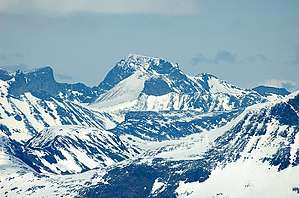
The geography of Scandinavia is extremely varied. Notable are the Norwegian fjords, the Scandinavian Mountains, the flat, low areas in Denmark and the archipelagos of Sweden and Norway. Sweden has many lakes and moraines, legacies of the ice age, which ended about ten millennia ago.
The southern and by far most populous regions of Scandinavia have a temperate climate. Scandinavia extends north of the Arctic Circle, but has relatively mild weather for its latitude due to the Gulf Stream. Many of the Scandinavian mountains have an alpine tundra climate.
The climate varies from north to south and from west to east: a marine west coast climate (Cfb) typical of western Europe dominates in Denmark, southernmost part of Sweden and along the west coast of Norway reaching north to 65°N, with orographic lift giving more mm/year precipitation (<5000 mm) in some areas in western Norway. The central part – from Oslo to Stockholm – has a humid continental climate (Dfb), which gradually gives way to subarctic climate (Dfc) further north and cool marine west coast climate (Cfc) along the northwestern coast.[6] A small area along the northern coast east of the North Cape has tundra climate (Et) as a result of a lack of summer warmth. The Scandinavian Mountains block the mild and moist air coming from the southwest, thus northern Sweden and the Finnmarksvidda plateau in Norway receive little precipitation and have cold winters. Large areas in the Scandinavian mountains have alpine tundra climate.
The warmest temperature ever recorded in Scandinavia is 38.0 °C in Målilla (Sweden).[7] The coldest temperature ever recorded is −52.6 °C in Vuoggatjålme, Arjeplog (Sweden).[8] The coldest month was February 1985 in Vittangi (Sweden) with a mean of −27.2 °C.[8]
Southwesterly winds further warmed by foehn wind can give warm temperatures in narrow Norwegian fjords in winter. Tafjord has recorded 17.9 °C in January and Sunndal 18.9 °C in February.
Etymology
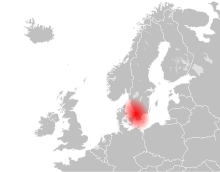
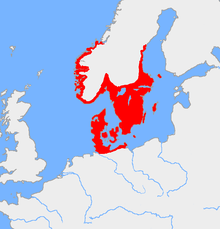
The words Scandinavia and Scania (Skåne, the southernmost province of Sweden) are both thought to go back to the Proto-Germanic compound *Skaðin-awjō (the ð represented in Latin by t or d), which appears later in Old English as Scedenig and in Old Norse as Skáney.[9] The earliest identified source for the name Scandinavia is Pliny the Elder's Natural History, dated to the first century AD.
Various references to the region can also be found in Pytheas, Pomponius Mela, Tacitus, Ptolemy, Procopius and Jordanes, usually in the form of Scandza. It is believed that the name used by Pliny may be of West Germanic origin, originally denoting Scania.[10] According to some scholars, the Germanic stem can be reconstructed as *skaðan- and meaning "danger" or "damage".[11] The second segment of the name has been reconstructed as *awjō, meaning "land on the water" or "island". The name Scandinavia would then mean "dangerous island", which is considered to refer to the treacherous sandbanks surrounding Scania.[11] Skanör in Scania, with its long Falsterbo reef, has the same stem (skan) combined with -ör, which means "sandbanks".
Alternatively, Sca(n)dinavia and Skáney, along with the Old Norse goddess name Skaði, may be related to Proto-Germanic *skaðwa- (meaning "shadow"). John McKinnell comments that this etymology suggests that the goddess Skaði may have once been a personification of the geographical region of Scandinavia or associated with the underworld.[12]
Another possibility is that all or part of the segments of the name came from the pre-Germanic Mesolithic people inhabiting the region.[13] In modernity, Scandinavia is a peninsula, but between approximately 10,300 and 9,500 years ago the southern part of Scandinavia was an island separated from the northern peninsula, with water exiting the Baltic Sea through the area where Stockholm is now located.[14] Correspondingly, some Basque scholars have presented the idea that the segment sk that appears in *Skaðinawjō is connected to the name for the Euzko peoples, akin to Basques, that populated Paleolithic Europe. According to one scholar, Scandinavian people share particular genetic markers with the Basque people.[13]
Appearance in medieval Germanic languages
The Latin names in Pliny's text gave rise to different forms in medieval Germanic texts. In Jordanes' history of the Goths (AD 551), the form Scandza is the name used for their original home, separated by sea from the land of Europe (chapter 1, 4).[15] Where Jordanes meant to locate this quasi-legendary island is still a hotly debated issue, both in scholarly discussions and in the nationalistic discourse of various European countries.[16][17] The form Scadinavia as the original home of the Langobards appears in Paulus Diaconus' Historia Langobardorum,[18] but in other versions of Historia Langobardorum appear the forms Scadan, Scandanan, Scadanan and Scatenauge.[19] Frankish sources used Sconaowe and Aethelweard, an Anglo-Saxon historian, used Scani.[20][21] In Beowulf, the forms Scedenige and Scedeland are used while the Alfredian translation of Orosius and Wulfstan's travel accounts used the Old English Sconeg.[21]
Possible influence on Sami
The earliest Sami yoik texts written down refer to the world as Skadesi-suolo (north Sami) and Skađsuâl (east Sami), meaning "Skaði's island". Svennung considers the Sami name to have been introduced as a loan word from the North Germanic languages;[22] "Skaði" is the giant stepmother of Freyr and Freyja in Norse mythology. It has been suggested that Skaði to some extent is modeled on a Sami woman. The name for Skade's father Thjazi is known in Sami as Čáhci, "the waterman"; and her son with Odin, Saeming, can be interpreted as a descendant of Saam the Sami population.[23][24] Older joik texts give evidence of the old Sami belief about living on an island and state that the wolf is known as suolu gievra, meaning "the strong one on the island". The Sami place name Sulliidčielbma means "the island's threshold" and Suoločielgi means "the island's back".
In recent substrate studies, Sami linguists have examined the initial cluster sk- in words used in Sami and concluded that sk- is a phonotactic structure of alien origin.[25]
Reintroduction of the term Scandinavia in the eighteenth century
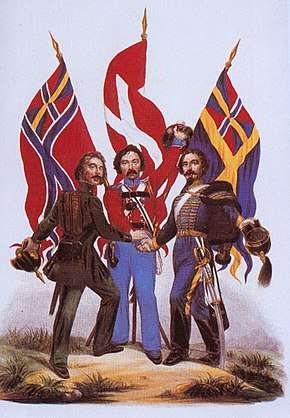
Although the term Scandinavia used by Pliny the Elder probably originated in the ancient Germanic languages, the modern form Scandinavia does not descend directly from the ancient Germanic term. Rather the word was brought into use in Europe by scholars borrowing the term from ancient sources like Pliny, and was used vaguely for Scania and the southern region of the peninsula.[26]
The term was popularised by the linguistic and cultural Scandinavist movement, which asserted the common heritage and cultural unity of the Scandinavian countries and rose to prominence in the 1830s.[26] The popular usage of the term in Sweden, Denmark and Norway as a unifying concept became established in the nineteenth century through poems such as Hans Christian Andersen's "I am a Scandinavian" of 1839. After a visit to Sweden, Andersen became a supporter of early political Scandinavism. In a letter describing the poem to a friend, he wrote: "All at once I understood how related the Swedes, the Danes and the Norwegians are, and with this feeling I wrote the poem immediately after my return: 'We are one people, we are called Scandinavians!'".
The influence of Scandinavism as a Scandinavist political movement peaked in the middle of the nineteenth century, between the First Schleswig War (1848–1850) and the Second Schleswig War (1864).
The Swedish king also proposed a unification of Denmark, Norway and Sweden into a single united kingdom. The background for the proposal was the tumultuous events during the Napoleonic Wars in the beginning of the century. This war resulted in Finland (formerly the eastern third of Sweden) becoming the Russian Grand Duchy of Finland in 1809 and Norway (de jure in union with Denmark since 1387, although de facto treated as a province) becoming independent in 1814, but thereafter swiftly forced to accept a personal union with Sweden. The dependent territories Iceland, the Faroe Islands and Greenland, historically part of Norway, remained with Denmark in accordance with the Treaty of Kiel. Sweden and Norway were thus united under the Swedish monarch, but Finland's inclusion in the Russian Empire excluded any possibility for a political union between Finland and any of the other Nordic countries.
The end of the Scandinavian political movement came when Denmark was denied the military support promised from Sweden and Norway to annex the (Danish) Duchy of Schleswig, which together with the (German) Duchy of Holstein had been in personal union with Denmark. The Second war of Schleswig followed in 1864, a brief but disastrous war between Denmark and Prussia (supported by Austria). Schleswig-Holstein was conquered by Prussia and after Prussia's success in the Franco-Prussian War a Prussian-led German Empire was created and a new power-balance of the Baltic sea countries was established. The Scandinavian Monetary Union, established in 1873, lasted until World War I.
Use of Nordic countries vs. Scandinavia
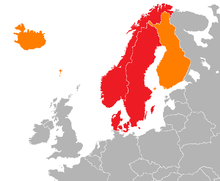
The term Scandinavia (sometimes specified in English as Continental Scandinavia or mainland Scandinavia) is commonly used strictly for Denmark, Norway and Sweden as a subset of the Nordic countries (known in Norwegian, Danish, and Swedish as Norden; Finnish: Pohjoismaat, Icelandic: Norðurlöndin, Faroese: Norðurlond).[27]
However, in English usage, the term Scandinavia is sometimes used as a synonym or near-synonym for Nordic countries.[5][28][29][30][31][32][33][34][35][36]
Debate about which meaning is more appropriate is complicated by the fact that usage in English is different from usage in the Scandinavian languages themselves (which use Scandinavia in the narrow meaning), and by the fact that the question of whether a country belongs to Scandinavia is politicised: people from the Nordic world beyond Norway, Denmark and Sweden may be offended at being either included in or excluded from the category of "Scandinavia".[37]
Nordic countries is used unambiguously for Denmark, Norway, Sweden, Finland and Iceland, including their associated territories (Svalbard, Greenland, the Faroe Islands and the Åland Islands).[5]
In addition to the mainland Scandinavian countries of:



The Nordic countries also consist of:

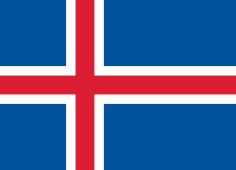
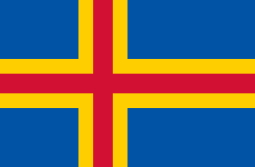
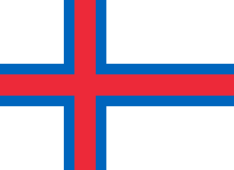
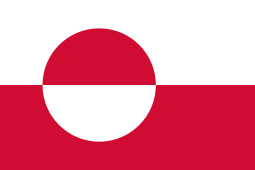


The clearest example of the use of the term Scandinavia as a political and societal construct is the unique position of Finland, based largely on the fact that most of modern-day Finland was part of Sweden for more than six centuries (see: Finland under Swedish rule), thus to much of the world associating Finland with all of Scandinavia. But the creation of a Finnish identity is unique in the region in that it was formed in relation to two different imperial models, the Swedish[38] and the Russian.[39][40][41]
There is also the geological term Fennoscandia (sometimes Fennoscandinavia), which in technical use refers to the Fennoscandian Shield (or Baltic Shield), that is the Scandinavian peninsula (Norway and Sweden), Finland and Karelia (excluding Denmark and other parts of the wider Nordic world). The terms Fennoscandia and Fennoscandinavia are sometimes used in a broader, political sense to refer to Norway, Sweden, Denmark, and Finland.[42]
Scandinavian as an ethnic term
Whereas both narrow and broad conceptions of Scandinavian countries are relatively straightforwardly defined, there is ambiguity and political contestation as to which people are Scandinavian people (or Scandinavians). English dictionaries usually define the noun Scandinavian as meaning any inhabitant of Scandinavia (which might be narrowly conceived or broadly conceived).[43][44][45] However, the noun Scandinavian is frequently used as a synonym for speakers of Scandinavian languages (languages descended from Old Norse). This usage can exclude the indigenous Sámi people of Scandinavia.[46]
Thus, Scandinavians always include Scandinavian-speaking Swedes, Norwegians, and Danes (and, earlier, speakers of the North Germanic languages). In usages based on cultural/linguistic definitions (native speakers of North Germanic languages), Scandinavians also include Faroe Islanders, Icelanders, the Swedish-speaking population of Finland, the Swedish-speaking population of Estonia, and the Scandinavian diaspora.
In usages based on geographical definitions (inhabitants of Continental Scandinavia), Scandinavians include Sami people and, depending on how broad an understanding of Scandinavia is being used, Finns and Inuit.[32]
Languages in Scandinavia
Two language groups have coexisted on the Scandinavian peninsula since prehistory—the North Germanic languages (Scandinavian languages) and the Sami languages.[47]
The majority of the population of Scandinavia (including Iceland and the Faroe Islands) today derive their language from several North Germanic tribes who once inhabited the southern part of Scandinavia and spoke a Germanic language that evolved into Old Norse and from Old Norse into Danish, Swedish, Norwegian, Faroese, and Icelandic. The Danish, Norwegian and Swedish languages form a dialect continuum and are known as the Scandinavian languages—all of which are considered mutually intelligible with one another. Faroese and Icelandic, sometimes referred to as insular Scandinavian languages, are intelligible in continental Scandinavian languages only to a limited extent.
A small minority of Scandinavians are Sami people, concentrated in the extreme north of Scandinavia.
Finland (sometimes included in Scandinavia in English usage) is mainly populated by speakers of Finnish, with a minority of approximately 5%[48] of Swedish speakers. However, Finnish is also spoken as a recognized minority language in Sweden, including in distinctive varieties sometimes known as Meänkieli. Finnish is distantly related to the Sami languages, but these are entirely different in origin to the Scandinavian languages.
German (in Denmark), Yiddish and Romani are recognized minority languages in parts of Scandinavia. More recent migrations has added even more languages. Apart from Sami and the languages of minority groups speaking a variant of the majority language of a neighboring state, the following minority languages in Scandinavia are protected under the European Charter for Regional or Minority Languages: Yiddish, Romani Chib/Romanes and Romani.
North Germanic languages
The North Germanic languages of Scandinavia are traditionally divided into an East Scandinavian branch (Danish and Swedish) and a West Scandinavian branch (Norwegian, Icelandic and Faroese),[49][50] but because of changes appearing in the languages since 1600 the East Scandinavian and West Scandinavian branches are now usually reconfigured into Insular Scandinavian (ö-nordisk/øy-nordisk) featuring Icelandic and Faroese[51] and Continental Scandinavian (Skandinavisk), comprising Danish, Norwegian and Swedish.[52]
The modern division is based on the degree of mutual comprehensibility between the languages in the two branches.[53] The populations of the Scandinavian countries, with common Scandinavian roots in language, can—at least with some training—understand each other's standard languages as they appear in print and are heard on radio and television.
The reason Danish, Swedish and the two official written versions of Norwegian (Nynorsk and Bokmål) are traditionally viewed as different languages, rather than dialects of one common language, is that each is a well-established standard language in its respective country.
Danish, Swedish and Norwegian have since medieval times been influenced to varying degrees by Middle Low German and standard German. That influence came from not just proximity but also that Denmark and later Denmark-Norway ruling over the German speaking region of Holstein, and in Sweden with its close trade with the Hanseatic League.
Norwegians are accustomed to variation and may perceive Danish and Swedish only as slightly more distant dialects. This is because they have two official written standards, in addition to the habit of strongly holding on to local dialects. The people of Stockholm, Sweden and Copenhagen, Denmark have the greatest difficulty in understanding other Scandinavian languages.[54] In the Faroe Islands and Iceland, learning Danish is mandatory. This causes Faroese people as well as Icelandic people to become bilingual in two very distinct North Germanic languages, making it relatively easy for them to understand the other two Mainland Scandinavian languages.[55][56]
Although Iceland was under the political control of Denmark until a much later date (1918), very little influence and borrowing from Danish has occurred in the Icelandic language.[57] Icelandic remained the preferred language among the ruling classes in Iceland. Danish was not used for official communications, most of the royal officials were of Icelandic descent and the language of the church and law courts remained Icelandic.[58]
Finnish

The Scandinavian languages are (as a language family) unrelated to Finnish, Estonian and Sami languages, which as Uralic languages are distantly related to Hungarian. Owing to the close proximity, there is still a great deal of borrowing from the Swedish and Norwegian languages in the Finnish and Sami languages.[59] The long history of linguistic influence of Swedish on Finnish is also due to the fact that Finnish, the language of the majority in Finland, was treated as a minority language while Finland was part of Sweden. Finnish-speakers had to learn Swedish in order to advance to higher positions.[60] Swedish spoken in today's Finland includes a lot of words that are borrowed from Finnish, whereas the written language remains closer to that of Sweden.
Finland is officially bilingual, with Finnish and Swedish having mostly the same status at national level. Finland's majority population are Finns, whose mother tongue is either Finnish (approximately 95%), Swedish or both. The Swedish-speakers live mainly on the coastline starting from approximately the city of Porvoo (in the Gulf of Finland) up to the city of Kokkola (in the Bay of Bothnia). The Åland Islands, an autonomous province of Finland situated in the Baltic Sea between Finland and Sweden, are entirely Swedish-speaking. Children are taught the other official language at school: for Swedish-speakers this is Finnish (usually from the 3rd grade), while for Finnish-speakers it is Swedish (usually from the 3rd, 5th or 7th grade).
Finnish speakers constitute a language minority in Sweden and Norway. Meänkieli and Kven are Finnish dialects spoken in Swedish Lapland and Norwegian Lapland.
Sami languages
The Sami languages are indigenous minority languages in Scandinavia.[61] They belong to their own branch of the Uralic language family and are unrelated to the North Germanic languages other than by limited grammatical (particularly lexical) characteristics resulting from prolonged contact.[59] Sami is divided into several languages or dialects.[62] Consonant gradation is a feature in both Finnish and northern Sami dialects, but it is not present in south Sami, which is considered to have a different language history. According to the Sami Information Centre of the Sami Parliament in Sweden, southern Sami may have originated in an earlier migration from the south into the Scandinavian peninsula.[59]
History
Ancient descriptions
A key ancient description of Scandinavia was provided by Pliny the Elder, though his mentions of Scatinavia and surrounding areas are not always easy to decipher. Writing in the capacity of a Roman admiral, he introduces the northern region by declaring to his Roman readers that there are 23 islands "Romanis armis cognitae" ("known to Roman arms") in this area. According to Pliny, the "clarissima" ("most famous") of the region's islands is Scatinavia, of unknown size. There live the Hilleviones. The belief that Scandinavia was an island became widespread among classical authors during the first century and dominated descriptions of Scandinavia in classical texts during the centuries that followed.
Pliny begins his description of the route to Scatinavia by referring to the mountain of Saevo ("mons Saevo ibi"), the Codanus Bay ("Codanus sinus") and the Cimbrian promontory.[63] The geographical features have been identified in various ways. By some scholars, Saevo is thought to be the mountainous Norwegian coast at the entrance to Skagerrak and the Cimbrian peninsula is thought to be Skagen, the north tip of Jutland, Denmark. As described, Saevo and Scatinavia can also be the same place.
Pliny mentions Scandinavia one more time: in Book VIII he says that the animal called achlis (given in the accusative, achlin, which is not Latin) was born on the island of Scandinavia.[64] The animal grazes, has a big upper lip and some mythical attributes.
The name Scandia, later used as a synonym for Scandinavia, also appears in Pliny's Naturalis Historia (Natural History), but is used for a group of Northern European islands which he locates north of Britannia. Scandia thus does not appear to be denoting the island Scadinavia in Pliny's text. The idea that Scadinavia may have been one of the Scandiae islands was instead introduced by Ptolemy (c. 90 – c. 168 AD), a mathematician, geographer and astrologer of Roman Egypt. He used the name Skandia for the biggest, most easterly of the three Scandiai islands, which according to him were all located east of Jutland.[11]
Neither Pliny's nor Ptolemy's lists of Scandinavian tribes include the Suiones mentioned by Tacitus. Some early Swedish scholars of the Swedish Hyperborean school[65] and of the ninettenth-century romantic nationalism period proceeded to synthesize the different versions by inserting references to the Suiones, arguing that they must have been referred to in the original texts and obscured over time by spelling mistakes or various alterations.[66][67]
| Part of a series on the |
| Norse people |
|---|
Extent of Norse language in 900 AD: Western Norse in red and Eastern Norse in orange. |
|
|
| WikiProject Norse history and culture |
The Middle Ages
During a period of Christianization and state formation in the 10th–13th centuries, numerous Germanic petty kingdoms and chiefdoms were unified into three kingdoms:
- Denmark, forged from the Lands of Denmark (including Jutland, Zealand and Scania (Skåneland) on the Scandinavian Peninsula)[68]
- Sweden, forged from the Lands of Sweden on the Scandinavian Peninsula (excluding the provinces Bohuslän, Härjedalen, Jämtland and Idre and Särna, Halland, Blekinge and Scania of modern-day Sweden, but including most of modern Finland)
- Norway (including Bohuslän, Härjedalen, Jämtland and Idre and Särna on the Scandinavian Peninsula and its island colonies Iceland, Greenland, Faroe Islands, Shetland, Orkney, Isle of Man and the Hebrides)
The three Scandinavian kingdoms joined in 1387 in the Kalmar Union under Queen Margaret I of Denmark. Sweden left the union in 1523 under King Gustav Vasa. In the aftermath of Sweden's secession from the Kalmar Union, civil war broke out in Denmark and Norway—the Protestant Reformation followed. When things had settled, the Norwegian Privy Council was abolished—it assembled for the last time in 1537. A personal union, entered into by the kingdoms of Denmark and Norway in 1536, lasted until 1814. Three sovereign successor states have subsequently emerged from this unequal union: Denmark, Norway and Iceland.
The borders between the three countries got the shape they have had since in the middle of the seventeenth century: In the 1645 Treaty of Brömsebro, Denmark–Norway ceded the Norwegian provinces of Jämtland, Härjedalen and Idre and Särna, as well as the Baltic Sea islands of Gotland and Ösel (in Estonia) to Sweden. The Treaty of Roskilde, signed in 1658, forced Denmark–Norway to cede the Danish provinces Scania, Blekinge, Halland, Bornholm and the Norwegian provinces of Båhuslen and Trøndelag to Sweden. The 1660 Treaty of Copenhagen forced Sweden to return Bornholm and Trøndelag to Denmark–Norway, and to give up its recent claims to the island Funen.[69]
In the east, Finland, was a fully incorporated part of Sweden since medieval times until the Napoleonic wars, when it was ceded to Russia. Despite many wars over the years since the formation of the three kingdoms, Scandinavia has been politically and culturally close.
Scandinavian unions

Denmark–Norway as a historiographical name refers to the former political union consisting of the kingdoms of Denmark and Norway, including the Norwegian dependencies of Iceland, Greenland and the Faroe Islands. The corresponding adjective and demonym is Dano-Norwegian. During Danish rule, Norway kept its separate laws, coinage and army as well as some institutions such as a royal chancellor. Norway's old royal line had died out with the death of Olav IV[70] in 1387, but Norway's remaining a hereditary kingdom became an important factor for the Oldenburg dynasty of Denmark–Norway in its struggles to win elections as kings of Denmark.
The Treaty of Kiel (14 January 1814) formally dissolved the Dano-Norwegian union and ceded the territory of Norway proper to the King of Sweden, but Denmark retained Norway's overseas possessions. However, widespread Norwegian resistance to the prospect of a union with Sweden induced the governor of Norway, crown prince Christian Frederick (later Christian VIII of Denmark), to call a constituent assembly at Eidsvoll in April 1814. The assembly drew up a liberal constitution and elected Christian Frederick to the throne of Norway. Following a Swedish invasion during the summer, the peace conditions of the Convention of Moss (14 August 1814) specified that king Christian Frederik had to resign, but Norway would keep its independence and its constitution within a personal union with Sweden. Christian Frederik formally abdicated on 10 August 1814 and returned to Denmark. The Norwegian parliament Storting elected king Charles XIII of Sweden as king of Norway on 4 November.
The Storting dissolved the union between Sweden and Norway in 1905, after which the Norwegians elected Prince Charles of Denmark as king of Norway: he reigned as Haakon VII.
Economy
The economies of the countries of Scandinavia are amongst the strongest in Europe.[71] There is a generous welfare system in Sweden, Denmark, Norway and Finland.[72]
Tourism
Various promotional agencies of the Nordic countries in the United States (such as The American-Scandinavian Foundation, established in 1910 by the Danish American industrialist Niels Poulsen) serve to promote market and tourism interests in the region. Today, the five Nordic heads of state act as the organization's patrons and according to the official statement by the organization its mission is "to promote the Nordic region as a whole while increasing the visibility of Denmark, Finland, Iceland, Norway and Sweden in New York City and the United States".[73] The official tourist boards of Scandinavia sometimes cooperate under one umbrella, such as the Scandinavian Tourist Board.[74] The cooperation was introduced for the Asian market in 1986, when the Swedish national tourist board joined the Danish national tourist board to coordinate intergovernmental promotion of the two countries. Norway's government entered one year later. All five Nordic governments participate in the joint promotional efforts in the United States through the Scandinavian Tourist Board of North America.[75]
See also
Notes
- "Scandinavia". Encyclopædia Britannica. 2009. Retrieved 28 October 2009.
Scandinavia, historically Scandia, part of Northern Europe, generally held to consist of the two countries of the Scandinavian Peninsula, Norway and Sweden, with the addition of Denmark. Some authorities argue for the inclusion of Finland on geologic and economic grounds and of Iceland and the Faroe Islands on the grounds that their inhabitants speak Scandinavian languages related to those of Norway and Sweden and also have similar cultures.
- Danish, Swedish and archaic (Dano-)Norwegian: Skandinavien, Norwegian, Faroese and Finnish: Skandinavia, Icelandic: Skandinavía, Sami: Skadesi-suolu/Skađsuâl
References
- "Languages". Nordic Cooperation. Archived from the original on 5 July 2017. Retrieved 8 July 2017.
- Landes, David (1 July 2009). "Swedish becomes official 'main language'". The Local (Se). Retrieved 8 July 2017.
- "Definition of Scandinavia in English". Oxford Dictionaries. Retrieved 23 December 2016.
A large peninsula in north-western Europe, occupied by Norway and Sweden … A cultural region consisting of the countries of Norway, Sweden, and Denmark and sometimes also of Iceland, Finland, and the Faroe Islands
- John Harrison, Michael Hoyler, Megaregions: Globalization's New Urban Form? (p. 152), Edward Elgar Publishing, 2015
- "Facts about the Nordic region". Nordic Council of Ministers & Nordic Council. 1 October 2007. Archived from the original on 8 February 2018. Retrieved 25 March 2014.
Denmark, Finland, Iceland, Norway, Sweden and the Faroe Islands, Greenland and Åland work together in the official Nordic co-operation.
- Battaglia, Steven M. (2 January 2019). "Shifting Weather Patterns in a Warming Arctic: The Scandes Case". Weatherwise. 72 (1): 23–29. doi:10.1080/00431672.2019.1538761.
- Högsta uppmätta temperatur i Sverige Archived 26 August 2010 at the Wayback Machine
- Lägsta uppmätta temperatur i Sverige Archived 28 December 2008 at the Wayback Machine
- Anderson, Carl Edlund (1999). Formation and Resolution of Ideological Contrast in the Early History of Scandinavia. PhD dissertation, Department of Anglo-Saxon, Norse & Celtic (Faculty of English), University of Cambridge, 1999.
- Haugen, Einar (1976). The Scandinavian Languages: An Introduction to Their History. Cambridge, Massachusetts: Harvard University Press, 1976.
- Knut Helle (2003). The Cambridge History of Scandinavia: Prehistory to 1520. Cambridge University Press. ISBN 978-0-521-47299-9.
- John McKinnell (2005). Meeting the other in Norse myth and legend. Ds Brewer. p. 63. ISBN 978-1-84384-042-8.
- J. F. Del Giorgio (24 May 2006). The Oldest Europeans: Who Are We? Where Do We Come From? What Made European Women Different?. A J Place. ISBN 978-980-6898-00-4.
- Uścinowicz, Szymon (2003). "How the Baltic Sea was changing" Archived 12 December 2007 at the Wayback Machine. Marine Geology Branch, Polish Geological Institute, 9 June 2003. Retrieved 13 January 2008.
- Jordanes (translated by Charles C. Mierow), The Origins and Deeds of the Goths, 22 April 1997
- Hoppenbrouwers, Peter (2005). Medieval Peoples Imagined. Working Paper No. 3, Department of European Studies, University of Amsterdam, ISSN 1871-1693, p. 8: "A second core area was the quasi-legendary 'Isle of Scanza', the vague indication of Scandinavia in classical ethnography, and a veritable 'hive of races and a womb of peoples' according to Jordanes' Gothic History. Not only the Goths were considered to have originated there, but also the Dacians/Danes, the Lombards, and the Burgundians—claims that are still subject to debate."
- Goffart, Walter (2005), "Jordanes’s Getica and the disputed authenticity of Gothic origins from Scandinavia". Speculum. A Journal of Medieval Studies 80, 379–98
- Paulus Diaconus, Historia Langobardorum, Bibliotheca Ausustana
- History of the Langobards, Northvegr Foundation Archived 6 April 2010 at the Wayback Machine
- Erik Björkman (1973). Studien zur englischen Philologie. Max Niemeyer. p. 99. ISBN 978-3-500-28470-5.
- Richard North (1997). Heathen gods in Old English literature. Cambridge University Press. p. 192. ISBN 978-0-521-55183-0.
- Svennung, J. (1963). Scandinavia und Scandia. Lateinisch-nordische Namenstudien. Almqvist & Wiksell/Harrassowitz, 1963, pp. 54–56.
- Mundel, E. (2000). "Coexistence of Saami and Norse culture – reflected in and interpreted by Old Norse myths" Coexistence of Saami and Norse culture – reflected in and interpreted by Old Norse myths University of Bergen, 11th Saga Conference Sydney 2000
- Steinsland, Gro (1991). Det hellige bryllup og norrøn kongeideologi. En analyse av hierogami-myten i Skírnismál, Ynglingatal, Háleygjatal og Hyndluljóð. Oslo: Solum, 1991. (In Norwegian).
- Aikio, A. (2004). "An essay on substrate studies and the origin of Saami". In Etymologie, Entlehnungen und Entwicklungen: Festschrift für Jorma Koivulehto zum 70. Geburtstag. Mémoires de la Société Néophilologique de Helsinki 63, Eds. Irma Hyvärinen / Petri Kallio / Jarmo Korhonen, Helsinki, pp. 5–34 (p. 14: "On the basis of Scandinavian loanwords it can be inferred that both sk- and -ʃ- were adopted in the west during the early separate development of the Saami languages, but never spread to Kola Saami. These areal features thus emerged in a phase when Proto-Saami began to diverge into dialects anticipating the modern Saami languages.")
- Østergård, Uffe (1997). "The Geopolitics of Nordic Identity – From Composite States to Nation States". The Cultural Construction of Norden. Øystein Sørensen and Bo Stråth (eds.), Oslo: Scandinavian University Press 1997, 25–71. Also published online at Danish Institute for International Studies Archived 14 November 2007 at the Wayback Machine. For the history of cultural Scandinavism, see Oresundstid's articles The Literary Scandinavism and The Roots of Scandinavism. Retrieved 19 January 2007.
- "Scandinavia". Microsoft Encarta Online Encyclopedia. Microsoft Corporation. 1997–2007. Archived from the original on 28 October 2009. Retrieved 30 January 2007.
Scandinavia (ancient Scandia), name applied collectively to three countries of northern Europe—Norway, Sweden (which together form the Scandinavian Peninsula) and Denmark.
- "Scandinavia". The Merriam-Webster Online Dictionary. 2008. Retrieved 9 January 2008.
Scandinavia: Denmark, Norway, Sweden—sometimes also considered to include Iceland, the Faeroe Islands, & Finland.
- 'Scandinavia', Collins Cobuild.
- 'Scandinavia, proper noun', Lexico: Powered by Oxford.
- 'Scandinavia, geographical name', Merriam Webster.
- Knut Helle, 'Introduction', in The Cambridge History of Scandinavia, Volume I: Prehistory to 1520, ed. by Knut Helle, E. I. Kouri, and Jens E. Oleson (Cambridge: Cambridge University Press, 2003), pp. 1-14 (pp. 1-4).
- "Scandinavia". Encyclopædia Britannica. 2009. Retrieved 28 October 2009.
Scandinavia, historically Scandia, part of northern Europe, generally held to consist of the two countries of the Scandinavian Peninsula, Norway and Sweden, with the addition of Denmark. Some authorities argue for the inclusion of Finland on geologic and economic grounds and of Iceland and the Faroe Islands on the grounds that their inhabitants speak Scandinavian languages related to those of Norway and Sweden and also have similar cultures.
- Lonely Planet Scandinavian Europe. 2009.
- The Rough Guide to Scandinavia. 2008.
- "Official Site of Scandinavian Tourist Board of North America". 2009. Retrieved 23 October 2008.
- Olwig, Kenneth R. "Introduction: The Nature of Cultural Heritage, and the Culture of Natural Heritage—Northern Perspectives on a Contested Patrimony". International Journal of Heritage Studies, Vol. 11, No. 1, March 2005, pp. 3–7.
- "Finland and the Swedish Empire". Country Studies. U.S. Library of Congress. Retrieved 25 November 2006.
- "Introduction: Reflections on Political Thought in Finland." Editorial. Redescriptions, Yearbook of Political Thought and Conceptual History, 1997, Volume 1, University of Jyväskylä, pp. 6–7: "[T]he populist opposition both to Sweden as a former imperial country and especially to Swedish as the language of the narrow Finnish establishment has also been strong, especially in the inter-war years. [...] Finland as a unitary and homogeneous nation-state was constructed [...] in opposition to the imperial models of Sweden and Russia."
- "The Rise of Finnish Nationalism". Country Studies. U.S. Library of Congress. Retrieved 25 November 2006: "The eighteenth century had witnessed the appearance of [...] a sense of national identity for the Finnish people, [...] an expression of the Finns' growing doubts about Swedish rule [...] The ethnic self-consciousness of Finnish speakers was given a considerable boost by the Russian conquest of Finland in 1809, because ending the connection with Sweden forced Finns to define themselves with respect to the Russians."
- Editors and Board, Redescriptions, Yearbook of Political Thought and Conceptual History
- "Fennoscandia, n.", Oxford English Dictionary Online, 2nd edn (Oxford: Oxford University Press, December 2019). Accessed 10 February 2020.
- 'Scandinavian, noun', Lexico: Powered By Oxford.
- 'Scandinavian noun', Merriam-Webster.
- 'Scandinavian 2. countable noun', Collins Cobuild.
- Kennedy, Arthur Garfield (1963). "The Indo-European Language Family". In Lee, Donald Woodward (ed.). English Language Reader: Introductory Essays and Exercises. Dodd, Mead.
North Germanic, or Scandinavian, or Norse, peoples, as they are variously called, became a distinctive people...
CS1 maint: ref=harv (link); Spaeth, John Duncan Ernst (1921). Old English Poetry. Princeton University Press.The main divisions of Germanic are: 1. East Germanic, including the Goths, both Ostrogoths and Visigoths. 2. North Germanic, including the Scandinavians, Danes, Icelanders, Swedes, "Norsemen." 3. West Germanic. The Old English (Anglo-Saxons) belong to this division, of which the continental representatives are the Teutonic peoples, High and Low Franks and Saxons, Alemanni, etc.
CS1 maint: ref=harv (link); Thompson, Stith (1995). Our Heritage of World Literature. Cordon Company. ISBN 978-0809310913.The North Germanic, or Scandinavian group, consists of the Norwegians, Danes, Swedes, and Icelanders.
CS1 maint: ref=harv (link); Gordon, Eric Valentine; Taylor, A. R. (1962). An Introduction to Old Norse. Clarendon Press.Norse was the language spoken by the North Germanic peoples (Scandinavians) from the time when Norse first became differentiated from the speech of the other Germanic peoples
CS1 maint: ref=harv (link); Ränk, Gustav (1976). Old Estonia, The People and Culture. Indiana University.Contacts are not impossible also with the Northern Germanic peoples, i.e., with the Scandinavians directly across the sea...
CS1 maint: ref=harv (link); Barbour, Stephen; Stevenson, Patrick (1990). Variation in German: A Critical Approach to German Sociolinguistics. Cambridge University Press. ISBN 978-0521357043.For the period when the existence of the Germanic tribes is first clearly recorded by Roman writers, archaeological evidence suggests five tribal groups, with perhaps five incipient distinct Germanic languages, as follows: (1) North Germanic tribes (Scandinavians)...
CS1 maint: ref=harv (link); Diringer, David (1948). The Alphabet: A Key to the History of Mankind. Philosophical Library."Old Norse" was spoken by the North Germanic or Scandinavian peoples
CS1 maint: ref=harv (link); Bolling, George Melville; Bloch, Bernard (1968). Language. Linguistic Society of America.Northern Germanic peoples, i.e. the Scandinavians...
CS1 maint: ref=harv (link); Jones, Gwyn (2001). A History of the Vikings. Oxford University Press. ISBN 978-0192801340.North Germanic (Scandinavian) peoples...
CS1 maint: ref=harv (link). - Dirmid R. F. Collis (1990). Arctic languages: an awakening. Unipub. p. 440. ISBN 978-92-3-102661-4.
- "Population".
- Aschehoug og Gyldendals store norske leksikon: Nar – Pd. 1999. ISBN 978-82-573-0703-5.
- Gordon, Raymond G., Jr. (ed.), 2005. Ethnologue: Languages of the World, Fifteenth edition. Dallas, Tex.: SIL International
- Jónsson, Jóhannes Gísli and Thórhallur Eythórsson (2004). "Variation in subject case marking in Insular Scandinavian". Nordic Journal of Linguistics (2005), 28: 223–245 Cambridge University Press. Retrieved 9 November 2007.
- Bernd Heine; Tania Kuteva (2006). The changing languages of Europe. Oxford University Press, US. ISBN 978-0-19-929734-4.
- Iben Stampe Sletten; Nordisk Ministerråd (2005). Nordens sprog med rødder og fødder. p. 2. ISBN 978-92-893-1041-3.
- "Urban misunderstandings", Nordic Council and the Nordic Council of Ministers, Copenhagen.
- Faroese and Norwegians best at understanding Nordic neighbours, Nordisk Sprogråd, Nordic Council, 13 January 2005.
- Aðalnámskrá grunnskóla: Erlend tungumál, ISMennt, EAN, 1999.
- Holmarsdottir, H. B. (2001). "Icelandic: A Lesser-Used Language in the Global Community". International Review of Education/ Internationale Zeitschrift Fr Erziehungswissenschaft/ Revue Inter. 47 (3/4): 379. Bibcode:2001IREdu..47..379H. doi:10.1023/A:1017918213388.
- Hálfdanarson, Guðmundur. Icelandic Nationalism: A Non-Violent Paradigm? Archived 1 October 2008 at the Wayback Machine In Nations and Nationalities in Historical Perspective. Pisa: Edizioni Plus, 2001, p. 3.
- Inez Svonni Fjällström (2006). "A language with deep roots" Archived 5 October 2007 at the Wayback Machine.Sápmi: Language history, 14 November 2006. Samiskt Informationscentrum Sametinget: "The Scandinavian languages are Northern Germanic languages. [...] Sami belongs to the Finno-Ugric language family. Finnish, Estonian, Livonian and Hungarian belong to the same language family and are consequently related to each other."
- Suzanne Romaine (1995). Bilingualism. Wiley-Blackwell. p. 323. ISBN 978-0-631-19539-9.
- Oskar Bandle (March 2005). The Nordic languages: an international handbook of the history of the North Germanic languages. Walter de Gruyter. p. 2115. ISBN 978-3-11-017149-5.
- www.eng.samer.se – The Sami dialects Archived 20 January 2009 at the Wayback Machine Sapmi: The Sami dialects
- Pliny the Elder. Naturalis Historia. Book IV, chapter XXXIX. Ed. Karl Friedrich Theodor Mayhoff. Online version at Persus. Retrieved 2 October 2007.
- Pliny the Elder. Naturalis Historia. Book VIII, chapter XVII. Ed. Karl Friedrich Theodor Mayhoff. Online version at Persus. Retrieved 2 October 2007.
- Oskar Bandle (2002). The Nordic languages: an international handbook of the history of the North Germanic languages. Mouton De Gruyter. p. 358. ISBN 978-3-11-014876-3.
- Malone, Kemp (1924). "Ptolemy's Skandia". The American Journal of Philology, Vol. 45, No. 4. (1924), pp. 362–70.
- Stadius, Peter (2001). "Southern Perspectives on the North: Legends, Stereotypes, Images and Models" Archived 25 October 2007 at the Wayback Machine. BaltSeaNet Working Paper 3, The Baltic Sea Area Studies, Gdansk/Berlin, 2001. Online version retrieved 2 October 2007.
- Oskar Bandle (2002). The Nordic languages: an international handbook of the history of the North Germanic languages. Mouton De Gruyter. ISBN 978-3-11-014876-3.
- "Treaty of Copenhagen" (2006). In Encyclopædia Britannica. Retrieved 9 November 2006, from Encyclopædia Britannica Online.
- The Monarchy: Historical Background. The Royal House of Norway. Official site. Retrieved 9 November 2006.
- "GDP Ranked by Country 2020". worldpopulationreview.com. Retrieved 28 January 2020.
- McWhinney, James. "The Nordic Model: Pros and Cons". Investopedia. Retrieved 28 January 2020.
- About The American-Scandinavian Foundation. Official site. Retrieved 2 February 2007.
- Scandinavian Tourist Board. Official site. Archived 17 January 2008 at the Wayback Machine
- The Scandinavian Tourist Board of North America. Official Website. Retrieved 2 February 2007.
External links
| Look up scandinavia in Wiktionary, the free dictionary. |
| Wikimedia Commons has media related to: |
| Wikisource has the text of the 1911 Encyclopædia Britannica article Scandinavian Civilization. |
- "Scandinavia: Official Website of the Scandinavian Tourist Boards in North America". Scandinavian Tourist Boards in North America, Globescope Internet Services, Inc. 2005. Retrieved 5 September 2008.
- Nordic Council – official site for co-operation in the Nordic region
- Nordregio – site established by the Nordic Council of Ministers
- vifanord – a digital library that provides scientific information on the Nordic and Baltic countries as well as the Baltic region as a whole
- Expat Scandinavia – Site with useful information for expats in Scandinavia.
